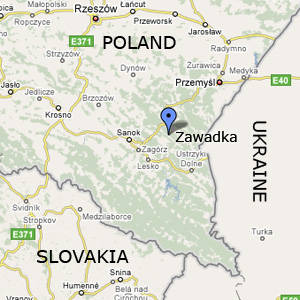Zawadka
Zawadka is a village, which is spreading out several km along one long street and in a narrow and closed streem valley Tarnawka, eastwards from the Tyrawa Woloska. From the South is shield by higland massif running by south-east direction, reaching 624 m. The hills in the east reache 526 m, in the south 547 m. Zawadka borders on the south-east with the Ropienka and on the south-west with the Rozpuciem. Zawadka is 14 km north-east from Sanok. Through the village takes its course the „red road” from Birczy to Rakove (lane 5.1). Buses are going here from Leska. Area is located nowadays in Polland, near to slovak and ukraiine border. It was part of Austro-Hungarian monarchy, called Galicia in the past.
The village Zawadka has arrised thanks to the colonial action of the family Tyrawski. The first informations about Zawadka comes from the year 1508 – there were a manor, the property of the Jan Tyravski, together with Tyrawa Woloska. First mention about parish is coming from year 1526. According to a local fame, based on the lost chronicle, which was cherished in the church, there was a village called Wykopanka, instead of Zawadka, which was burned during some hold-up 300 years ago. The name Zawadka has the polish origin and means „the place, where was partitioned the crossing in case of foreign army invasion”. This parish church in Zawadka is remembered since 1526 . In the 19th and 20th century Zawadka stepwise belonged to Karwaszewski, Lanerich, Bytkowski, Mickiewicz, Sokolowicz a Langsam families. The other owners brought many crafts to the area and they placed them in various parts of the villages – because of that they have names like Furmany, Lokaje, Ogrodniki.


During the last two centuries there were produced carbonate of potash (pearl ash), there was burnt out the lime, worked the brickworks, the mill and water saw. In Zawadka lived also several weavers, who produced canvas for needs of the village. In 1921 there were 149 houses and 759 inhabitans (575 greek catholics, 166 roman catholics, 18 jews). At the end of the millenium the Zawadka had just 77 houses and 563 inhabitans.
Before the World War II the Zawadka was tenanted by both Ruthenian and Polish. During the wars with Ukrainian Insurgent Army (UPA) the upper part of the village was burnt, most of others buildings was demolished after 1947. Several old buildings in the valley were saved. On the 3th March 1945 the partisans from UPA killed one inhabitant of the village, and trashed another one for collaboration with police – both were Ukrainians. During the operation „Visla“ (in May 1947) 695 persons was displaced from here on so-called „Gained territory”. Only the workers of the oil well near Ropienka avoid the displacement. Near Zawadka on the 13th June 1947 the commander of UPA, Jaroslaw Kociolok „Krylacz“, perished in the war with polish forces.
Till these days there have come down several wood houses of the type „one-building fence” in Zawadka. Wooden greek-catholic parish church called Saint Paraskevie was built in 1838 and demolished about year 1951. It wasb a bipartite building, covered by roof with a bulbous part above the bay. The bell-tower was standing extra, doubtless from 1898. Round about there were two cemeteries (old and new), on which have come down few old tombs. Moreover, there is a stone monument from 1835 in the village and a walled chapel from 19th century with the picture of the God's Mother. From the stone church remained also the stone font, dated to 1866, which is at the enter to the cemetery, fenced by wire-netting. In the cemetery are placed some interesting old tombs. One of them is made from a sandstone in all, has got an unusual design of the cavitation chapel perched on the pillar. Similar shape has a stone monument from 1835, standing by the roadside.
